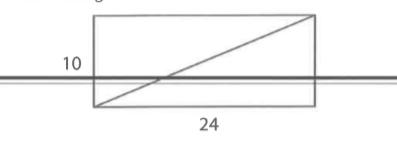The extremities of a diagonal of a rectangle are (0,0) and (4,3). The equation of tangents to the circumcircle of the rectangle which are parallel to the diagonal are
Step by step video & image solution for The extremities of a diagonal of a rectangle are (0,0) and (4,3). The equation of tangents to the circumcircle of the rectangle which are parallel to the diagonal are by Maths experts to help you in doubts & scoring excellent marks in Class 12 exams.
Updated on:21/07/2023Topper's Solved these Questions
Similar Questions
Extremities of a diagonal of a rectangle are (0, 0) and (4, 3). The equations of the tangents to the circumcircle of the rectangle which are parallel to the diagonal, are
View SolutionThe extremities of a diagonal of a rectangle are (0.0) and (4, 4). The locus of the extremities of the other diagonal is equal to
View SolutionThe diagonals of a rectangle are of equal length.
View SolutionThe extremities of a diagonal of a rectangle are (−4,4)and(6,−1). A circle circumscribes the rectangle and cuts an intercept AB on the y-axis. If Δ be the area of the triangle formed by AB and the tangents to the circle at AandB, then 8Δ=.
View SolutionThe extremities of the diagonal of a rectangle are (−4,4) and (6,−1). A circle circumscribes the rectangle and cuts inercept of length AB on the y-axis. The length of AB is
View SolutionWhat is the diagonal of the rectangle shown?

View SolutionThe diagonals of a rectangle bisect each other
View SolutionThe co-ordinates of the extremities of one diagonal of a square are (1,1) and (−1,−1) Find the co-ordinates of its other vertices and the equation of the other diagonal
View SolutionThe co-ordinates of the extremities of one diagonal of a square are (1,1) and (1,−1) Find the co-ordinates of its other vertices and the equation of the other diagonal
View SolutionProve analytically that the diagonals of a rectangle are equal
View Solution
